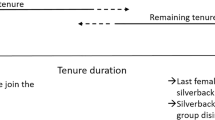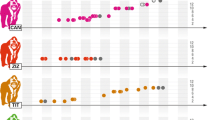Abstract
The evolution of social monogamy in larger mammals is difficult to explain because males usually do not invest much in direct offspring care and might achieve greater fitness by deserting a pregnant female to reproduce with additional females elsewhere. It has been hypothesized that socially monogamous males remain with the female year-round to protect their offspring from infanticide by new immigrant males. We investigated this idea by analyzing all cases of infant loss in a wild population of white-handed gibbons (Hylobates lar; Primates), in which most groups were socially monogamous and some polyandrous (137.5 group years). We examined the influence of (a) male intruder pressure on male immigration rates and (b) the presence of a new male in the group on infant loss. We found no relation between intruder pressure and male immigration rates. Infant loss was lowest (4.5%) for stable monogamy (probable father stayed from conception through infancy) and intermediate (25.0%; p = 0.166) for stable polyandry. If a new male immigrated after conception, however, the infant was lost in all cases (p < 0.01) independent of the presumed father’s presence. Overall, 83.3% of infant losses were associated with the presence of a presumably unrelated male. Although the sample size is small, our results provide the first true support for the idea that the risk of infanticide is an important factor in the evolution of social monogamy in larger mammals.


Similar content being viewed by others
References
Agrell J, Wolff JO, Yloenen H (1998) Counter-strategies to infanticide in mammals: costs and consequences. Oikos 83:507–517
Alfred J, Sati J (1991) On the first record of infanticide in the hoolock gibbon—Hylobates hoolock in the wild. Rec Zool Surv India 89:319–321
Barelli C, Heistermann M, Boesch C, Reichard UH (2007) Sexual swellings in wild white-handed gibbon females (Hylobates lar) indicate the probability of ovulation. Horm Behav 51:221–230. doi:10.1016/j.yhbeh.2006.10.008
Barelli C, Heistermann M, Boesch C, Reichard UH (2008) Mating patterns and sexual swellings in pair-living and multimale groups of wild white-handed gibbons, Hylobates lar. Anim Behav 75:991–1001. doi:10.1016/j.anbehav.2007.08.012
Bartlett TQ (2007) The Hylobatidae: small apes of Asia. In: Campbell CJ, Fuentes A, MacKinnon KC, Panger M, Bearder SK (eds) Primates in perspective. Oxford University Press, New York, pp 274–289
Bateman AJ (1948) Intra-sexual selection in Drosophila. Heredity 2:349–368. doi:10.1038/hdy.1948.21
Borries C, Launhardt K, Epplen C, Epplen JT, Winkler P (1999a) DNA analyses support the hypothesis that infanticide is adaptive in langur monkeys. Proc R Soc Lond B 266:901–904. doi:10.1098/rspb.1999.0721
Borries C, Launhardt K, Epplen C, Epplen JT, Winkler P (1999b) Males as infant protectors in Hanuman langurs (Presbytis entellus) living in multimale groups - defence pattern, paternity and sexual behaviour. Behav Ecol Sociobiol 46:350–356. doi:10.1007/s002650050629
Brockelman WY (1998) Long term ecological research plot for the study of animal diets in Khao Yai National Park. In: Poonswad P (ed) The Asian hornbills: ecology and conservation. BRT, Bangkok, pp 307–310
Brockelman WY (2009) Ecology and the social system of gibbons. In: Lappan S, Whittaker DJ (eds) The gibbons: new perspectives on small ape socioecology and population biology. Springer, New York, pp 211–239
Brockelman WY, Reichard UH, Treesucon U, Raemaekers JJ (1998) Dispersal, pair formation and social structure in gibbons (Hylobates lar). Behav Ecol Sociobiol 42:329–339. doi:10.1007/s002650050445
Brotherton PNM, Komers PE (2003) Mate guarding and the evolution of social monogamy in mammals. In: Reichard UH, Boesch C (eds) Monogamy: mating strategies and partnerships in birds, humans and other mammals. Cambridge University Press, Cambridge, pp 42–58
Chase ID (1991) Vacancy chains. Annu Rev Sociol 17:133–154. doi:10.1146/annurev.so.17.080191.001025
Clutton-Brock TH (1989) Mammalian mating systems. Proc R Soc Lond B 236:339–372. doi:10.1098/rspb.1989.0027
Dunbar RIM (1995) The mating system of callitrichid primates: I. conditions for the evolution of pair bonding and twinning. Anim Behav 50:1057–1070. doi:10.1016/0003-3472(95)80106-5
Ebensperber LA (1998) Strategies and counterstrategies to infanticide in mammals. Biol Rev 73:321–346. doi:10.1111/j.1469-185X.1998.tb00034.x
Fernandez-Duque E (2009) Natal dispersal in monogamous owl monkeys (Aotus azarai) of the Argentinean Chaco. Behaviour 146:583–606
Fuentes A (1998) Re-evaluating primate monogamy. Am Anthropol 100:890–907
Gowaty PA (1996a) Battle of the sexes and origin of monogamy. In: Black JM (ed) Partnerships in birds: the study of monogamy. Oxford University Press, Oxford, pp 21–52
Gowaty PA (1996b) Multiple mating by females selects for males that stay: another hypothesis for social monogamy in passerine birds. Anim Behav 51:482–484. doi:10.1006/anbe.1996.0052
Gubernick DJ (1994) Biparental care and male-female relations in mammals. In: Parmigiani S, vom Saal FS (eds) Infanticide and parental care. Harwood Academic Publishers, Chur, pp 427–463
Hrdy SB (1974) Male-male competition and infanticide among the langurs (Presbytis entellus) of Abu, Rajasthan. Folia Primatol 22:19–58. doi:10.1159/000155616
Hrdy SB (1979) Infanticide among animals: a review, classification, and examination of the implications for the reproductive strategies of females. Ethol Sociobiol 1:13–40. doi:10.1016/0162-3095(79)90004-9
Hrdy SB (1999) Mother nature—a history of mothers, infants, and natural selection. Pantheon Books, New York
Hrdy SB (2000) The optimal number of fathers—evolution, demography, and history in the shaping of female mate preferences. Ann NY Acad Sci 907:75–96. doi:10.1111/j.1749-6632.2000.tb06617.x
Kleiman DG (1977) Monogamy in mammals. Q Rev Biol 52:39–69
Koenig WD (1981) Space competition in the acorn woodpecker: power struggles in a cooperative breeder. Anim Behav 29:396–409. doi:10.1016/S0003-3472(81)80099-1
Koenig WD, Stacey PB (1990) Acorn woodpeckers: group-living and food storage under contrasting ecological conditions. In: Stacey PB, Koenig WD (eds) Cooperative breeding in birds: long-term studies of ecology and behavior. Cambridge University Press, Cambridge, pp 415–453
Komers PE, Brotherton PNM (1997) Female space use is the best predictor of monogamy in mammals. Proc R Soc Lond B 264:1261–1270. doi:10.1098/rspb.1997.0174
Lappan S (2007a) Patterns of dispersal in Sumatran siamangs (Symphalangus syndactylus): preliminary mtDNA evidence suggests more frequent male than female dispersal to adjacent groups. Am J Primatol 69:692–698. doi:10.1002/ajp.20382
Lappan S (2007b) Social relationships among males in multimale siamang groups. Int J Primatol 28:369–387. doi:10.1007/s10764-007-9122-z
Lappan S (2008) Male care of infants in a siamang (Symphalangus syndactylus) population including socially monogamous and polyandrous groups. Behav Ecol Sociobiol 62:1307–1317. doi:10.1007/s00265-008-0559-7
Leighton DR (1987) Gibbons: territoriality and monogamy. In: Smuts BB, Cheney DL, Seyfarth RM, Wrangham RW, Struhsaker TT (eds) Primate societies. University of Chicago Press, Chicago, pp 135–145
Lynam AJ, Round PD, Brockelman WY (2006) Status of birds and large mammals in Thailand’s Dong Phayayen—Khao Yai Forest Complex. BRT, Bangkok
Mitani JC (1990) Demography of agile gibbons (Hylobates agilis). Int J Primatol 11:411–424. doi:10.1007/BF02196129
Palombit RA (1994a) Dynamic pair bonds in hylobatids: implications regarding monogamous social systems. Behaviour 128:65–101. doi:10.1163/156853994X00055
Palombit RA (1994b) Extra-pair copulations in a monogamous ape. Anim Behav 47:721–723. doi:10.1006/anbe.1994.1097
Palombit RA (1999) Infanticide and the evolution of pair bonds in nonhuman primates. Evol Anthropol 7:117–129. doi:10.1002/(SICI)1520-6505(1999)7:4<117::AID-EVAN2>3.0.CO;2-O
Palombit RA (2000) Infanticide and the evolution of male-female bonds in animals. In: van Schaik CP, Janson CH (eds) Infanticide by males and its implications. Cambridge University Press, Cambridge, pp 239–268
Palombit RA, Cheney DL, Fischer J, Johnson SE, Rendall D, Seyfarth RM, Silk JB (2000) Male infanticide and defense of infants in chacma baboons. In: van Schaik CP, Janson CH (eds) Infanticide by males and its implications. Cambridge University Press, Cambridge, pp 123–152
Parker GA (1974) Assessment strategy and the evolution of fighting behaviour. J Theor Biol 47:223–243. doi:10.1016/0022-5193(74)90111-8
Pusey AE, Packer C (1987) The evolution of sex-biased dispersal in lions. Behaviour 101:275–310
Raemaekers JJ, Raemaekers PM (1985) Field playback of loud calls to gibbons (Hylobates lar): territorial, sex-specific and species-specific responses. Anim Behav 33:481–493. doi:10.1016/S0003-3472(85)80071-3
Reichard UH (1995) Extra-pair copulations in a monogamous gibbon (Hylobates lar). Ethology 100:99–112
Reichard UH (2003) Social monogamy in gibbons: the male perspective. In: Reichard UH, Boesch C (eds) Monogamy: mating strategies and partnerships in birds, humans and other mammals. Cambridge University Press, Cambridge, pp 190–213
Reichard UH (2009) The social organization and mating system of Khao Yai white-handed gibbons: 1992–2006. In: Lappan S, Whittaker DJ (eds) The gibbons: new perspectives on small ape socioecology and population biology. Springer, New York, pp 347–384
Reichard UH, Barelli C (2008) Life history and reproductive strategies of Khao Yai Hylobates lar: implications for social evolution in apes. Int J Primatol 29:823–844. doi:10.1007/s10764-008-9285-2
Reichard UH, Sommer V (1997) Group encounters in wild gibbons (Hylobates lar): agonism, affiliation, and the concept of infanticide. Behaviour 134:1135–1174. doi:10.1163/156853997X00106
Rutberg AT (1983) The evolution of monogamy in primates. J Theor Biol 104:93–112. doi:10.1016/0022-5193(83)90403-4
Savini T, Boesch C, Reichard UH (2008) Home-range characteristics and the influence of seasonality on female reproduction in white-handed gibbons (Hylobates lar) at Khao Yai National Park, Thailand. Am J Phys Anthropol 135:1–12. doi:10.1002/ajpa.20578
Savini T, Boesch C, Reichard UH (2009) Varying ecological quality influences the probability of polyandry in white-handed gibbons (Hylobates lar) in Thailand. Biotropica 41:503–513. doi:10.1111/j.1744-7429.2009.00507.x
Shuster SM, Wade MJ (2003) Mating systems and strategies. Princeton University Press, Princeton
Soltis J, Thomsen R, Matsubayashi K, Takenaka O (2000) Infanticide by resident males and female counter-strategies in wild Japanese macaques (Macaca fuscata). Behav Ecol Sociobiol 48:195–202. doi:10.1007/s002650000224
Sommer V, Reichard UH (2000) Rethinking monogamy: the gibbon case. In: Kappeler PM (ed) Primate males: causes and consequences of variation in group composition. Cambridge University Press, Cambridge, pp 159–168
Trivers RL (1972) Parental investment and sexual selection. In: Campbell BG (ed) Sexual selection and the descent of man, 1871–1971. Aldine-Atherton, Chicago, pp 136–179
van Schaik CP (2000a) Infanticide by male primates: the sexual selection hypothesis revisited. In: van Schaik CP, Janson CH (eds) Infanticide by males and its implications. Cambridge University Press, Cambridge, pp 27–60
van Schaik CP (2000b) Vulnerability to infanticide by males: patterns among mammals. In: van Schaik CP, Janson CH (eds) Infanticide by males and its implications. Cambridge University Press, Cambridge, pp 61–71
van Schaik CP, Dunbar RIM (1990) The evolution of monogamy in large primates: a new hypothesis and some crucial tests. Behaviour 115:30–61. doi:10.1163/156853990X00284
van Schaik CP, Janson CH (2000) Infanticide by males and its implications. Cambridge University Press, Cambridge
van Schaik CP, Kappeler PM (1997) Infanticide risk and the evolution of male–female association in primates. Proc R Soc Lond B 264:1687–1694. doi:10.1098/rspb.1997.0234
van Schaik CP, Kappeler PM (2003) The evolution of social monogamy in primates. In: Reichard UH, Boesch C (eds) Monogamy: mating strategies and partnerships in birds, humans and other mammals. Cambridge University Press, Cambridge, pp 59–80
Wich SA, van der Post DJ, Heistermann M, Moehle U, van Hooff JARAM, Sterck EHM (2003) Life-phase related changes in male loud call characteristics and testosterone levels in wild Thomas Langurs. Int J Primatol 24:1251–1265
Wich SA, Assink PR, Sterck EHM (2004) Thomas langurs (Presbytis thomasi) discriminate between calls of young solitary versus older group-living males: a factor in avoiding infanticide? Behaviour 141:41–51
Wittenberger JF, Tilson RL (1980) The evolution of monogamy: hypotheses and evidence. Annu Rev Ecol Syst 11:197–232. doi:10.1146/annurev.es.11.110180.001213
Wolff JO (1993) Why are female small mammals territorial? Oikos 68:364–370
Zuckerman S (1981) The social life of monkeys and apes, 2nd edn. Routledge & Kegan Paul, London
Acknowledgments
We thank the Royal Golden Jubilee Ph.D. Program for the opportunity to work together at Stony Brook University in the spring of 2009. For comments on an early version of the manuscript, we thank Robin I.M. Dunbar, Sarah B. Hrdy, Kerry Ossi-Lupo, the associate editor David Watts, and two anonymous reviewers.
Author information
Authors and Affiliations
Corresponding author
Additional information
Communicated by D.Watts
Rights and permissions
About this article
Cite this article
Borries, C., Savini, T. & Koenig, A. Social monogamy and the threat of infanticide in larger mammals. Behav Ecol Sociobiol 65, 685–693 (2011). https://doi.org/10.1007/s00265-010-1070-5
Received:
Revised:
Accepted:
Published:
Issue Date:
DOI: https://doi.org/10.1007/s00265-010-1070-5




